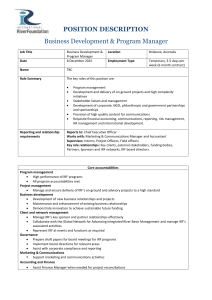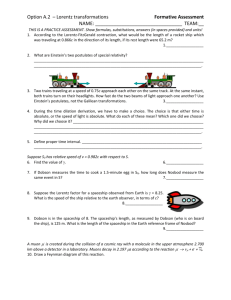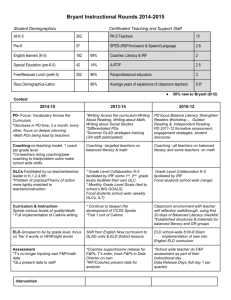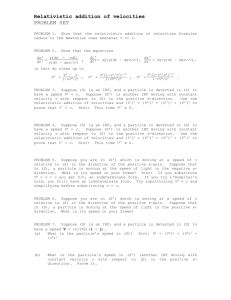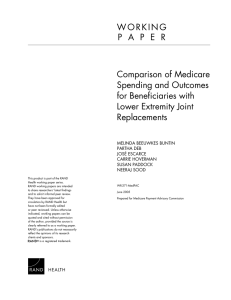Improving Program Efficiency by Packing Instructions into Registers
advertisement
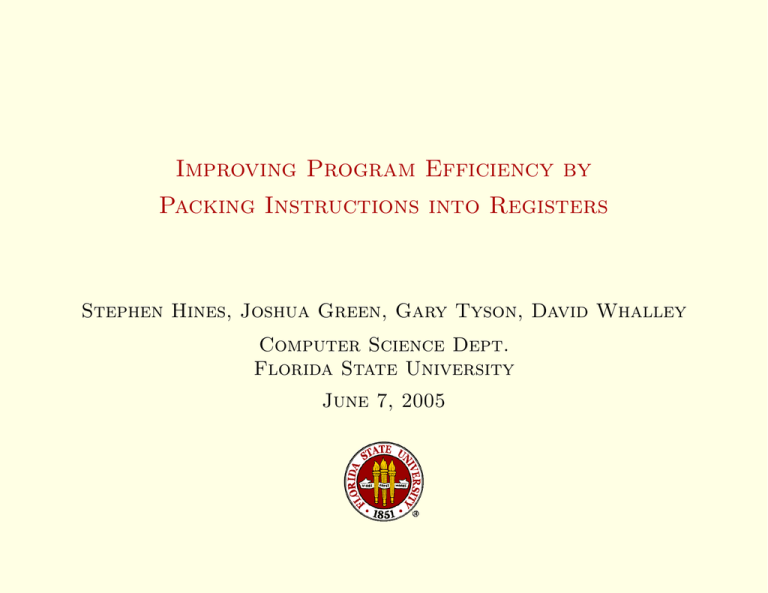
Improving Program Efficiency by
Packing Instructions into Registers
Stephen Hines, Joshua Green, Gary Tyson, David Whalley
Computer Science Dept.
Florida State University
June 7, 2005
◆ Introduction
• Embedded Processor Design Constraints
– Power Consumption
– Static Code Size
– Execution Time
• Fetch logic consumes 36% of total processor power on StrongARM
– Instruction Cache (IC) and/or ROM — Lower power than a large
memory store, but still a fairly large, flat storage method
• Instruction encodings can be wasteful with bits
– Nowhere near theoretical compression limits
– Maximize functionality, but simplify decoding (fixed length)
– Most applications only apply a subset of available instructions
Improving Program Efficiency by Packing Instructions into Registers
slide 1
◆ Access of Data & Instructions
Main Memory
L2 Cache
L1 Data Cache
L1 Instruction Cache
Data Register File
g???g
• Each lower layer is designed to improve accessibility of current/frequent
items, albeit at a reduction in number of available items
• Caching is beneficial, but compilers can do better for the “most
frequently” accessed data items (e.g. Register Allocation)
• Instructions have no analogue to the Data Register File (RF)
Improving Program Efficiency by Packing Instructions into Registers
slide 2
◆ Instruction Register File — IRF
IF Stage
First Half of ID Stage
instruction
buffer
IF/ID
PC
ROM
or
IRF
L1 IC
• Stores frequently occurring instructions as specified by the compiler
(potentially in a partially decoded state)
• Allows multiple instruction fetch with packed instructions
Improving Program Efficiency by Packing Instructions into Registers
slide 3
Total Instruction Frequency (%)
◆ Dynamic Instruction Redundancy
100
80
60
average
susan
pgp
patricia
gsm
jpeg
ghostscript
40
20
0
16
32
48
64
80
96
Number of Distinct Instructions
112
128
• Profiling the largest benchmark in each category of MiBench
• 32-entry IRF can capture 66.51% of all dynamic instructions executed
on average
Improving Program Efficiency by Packing Instructions into Registers
slide 4
◆ ISA Modifications
• MIPS ISA — commonly known and provides simple encoding
• RISA (Register ISA) — instructions available via IRF access
• MISA (Memory ISA) — instructions available in memory
– Create new instruction formats that can reference multiple RISA
instructions — Tightly Packed
– Modify original instructions to be able to pack an additional RISA
instruction reference — Loosely Packed
• Increase packing abilities
– Parameterization
– Positional Register Specifiers
Improving Program Efficiency by Packing Instructions into Registers
slide 5
◆ Tightly Packed Instruction Format
6 bits
5 bits
5 bits
5 bits
opcode
inst1
inst2
inst3
5 bits
inst4
param
1
s
5 bits
inst5
param
• New opcodes for this T-format of MISA instructions
• Supports sequential execution of up to 5 RISA instructions from the IRF
– Unnecessary fields are padded with nop
• Supports up to 2 parameters replacing instruction slots
– Parameters can come from 32-entry Immediate Table (IMM)
– Each IRF entry retains a default immediate value as well
– Branches use these 5-bits for displacements
Improving Program Efficiency by Packing Instructions into Registers
slide 6
◆ Positional Register Specifiers
#
1
2
3
4
5
6
RTL
r[2]=R[r[29]+4];
r[2]=r[2]+r[5];
R[r[29]+4]=r[2];
...
r[3]=R[r[29]+4];
r[3]=r[3]+r[5];
R[r[29]+4]=r[3];
RTL (positional)
r[2]=R[r[29]+4];
s[0]=s[0]+r[5];
R[u[2]+4]=s[0];
...
r[3]=R[r[29]+4];
s[0]=s[0]+r[5];
R[u[2]+4]=s[0];
• Abstract out common register usage patterns (e.g. load/add/store)
• Increases code redundancy, so greater opportunity for compression
• Positional register values can be obtained via modifications to standard
pipeline register forwarding logic
Improving Program Efficiency by Packing Instructions into Registers
slide 7
◆ Compiler Modifications
C Source Files
VPO
Compiler
Profiling
Executable
Static
Profile
Data
Executable
VPO
Compiler
IRF/IMM
Data
Dynamic
Profile
Data
IRF Analyzer
• VPO — Very Portable Optimizer targeted for SimpleScalar MIPS/Pisa
• IRF-resident instructions are selected by a greedy algorithm using profile
data including parameterization/positional hints
• Iterative packing process using a sliding window to allow branch
displacements to slip into (5-bit) range
Improving Program Efficiency by Packing Instructions into Registers
slide 8
Original Code Sequence
Instruction Register File
#
0
1
2
3
4
...
Instruction
nop
addiu r[5], r[3], 1
beq r[5], r[0], 0
addu r[5], r[5], r[4]
andi r[3], r[3],63
...
Default
NA
1
None
NA
63
...
lw r[3], 8(r[29])
andi r[3], r[3], 63
addiu r[5], r[3], 32
addu r[5], r[5], r[4]
beq r[5], r[0], −8
Immediate Table
#
...
3
4
...
Value
...
32
63
...
Improving Program Efficiency by Packing Instructions into Registers
slide 9
Instruction Register File
#
0
1
2
3
4
...
Instruction
nop
addiu r[5], r[3], 1
beq r[5], r[0], 0
addu r[5], r[5], r[4]
andi r[3], r[3],63
...
Immediate Table
#
...
3
4
...
Value
...
32
63
...
Original Code Sequence
Default
NA
1
None
NA
63
...
lw r[3], 8(r[29])
andi r[3], r[3], 63
addiu r[5], r[3], 32
addu r[5], r[5], r[4]
beq r[5], r[0], −8
Marked IRF Sequence
lw r[3], 8(r[29])
IRF[4], default (4)
IRF[1], param (3)
IRF[3]
IRF[2], param (branch −8)
Improving Program Efficiency by Packing Instructions into Registers
slide 9
Instruction Register File
#
0
1
2
3
4
...
Instruction
nop
addiu r[5], r[3], 1
beq r[5], r[0], 0
addu r[5], r[5], r[4]
andi r[3], r[3],63
...
Immediate Table
#
...
3
4
...
Value
...
32
63
...
Original Code Sequence
Default
NA
1
None
NA
63
...
lw r[3], 8(r[29])
andi r[3], r[3], 63
addiu r[5], r[3], 32
addu r[5], r[5], r[4]
beq r[5], r[0], −8
Marked IRF Sequence
lw r[3], 8(r[29])
IRF[4], default (4)
IRF[1], param (3)
IRF[3]
IRF[2], param (branch −8)
Improving Program Efficiency by Packing Instructions into Registers
slide 9
Instruction Register File
#
0
1
2
3
4
...
Instruction
nop
addiu r[5], r[3], 1
beq r[5], r[0], 0
addu r[5], r[5], r[4]
andi r[3], r[3],63
...
Immediate Table
#
...
3
4
...
Value
...
32
63
...
Original Code Sequence
Default
NA
1
None
NA
63
...
lw r[3], 8(r[29])
andi r[3], r[3], 63
addiu r[5], r[3], 32
addu r[5], r[5], r[4]
beq r[5], r[0], −8
Marked IRF Sequence
lw r[3], 8(r[29])
IRF[4], default (4)
IRF[1], param (3)
IRF[3]
IRF[2], param (branch −8)
Improving Program Efficiency by Packing Instructions into Registers
slide 9
Instruction Register File
#
0
1
2
3
4
...
Instruction
nop
addiu r[5], r[3], 1
beq r[5], r[0], 0
addu r[5], r[5], r[4]
andi r[3], r[3],63
...
Immediate Table
#
...
3
4
...
Value
...
32
63
...
Original Code Sequence
Default
NA
1
None
NA
63
...
lw r[3], 8(r[29])
andi r[3], r[3], 63
addiu r[5], r[3], 32
addu r[5], r[5], r[4]
beq r[5], r[0], −8
Marked IRF Sequence
lw r[3], 8(r[29])
IRF[4], default (4)
IRF[1], param (3)
IRF[3]
IRF[2], param (branch −8)
Improving Program Efficiency by Packing Instructions into Registers
slide 9
Instruction Register File
#
0
1
2
3
4
...
Instruction
nop
addiu r[5], r[3], 1
beq r[5], r[0], 0
addu r[5], r[5], r[4]
andi r[3], r[3],63
...
Immediate Table
#
...
3
4
...
Value
...
32
63
...
Original Code Sequence
Default
NA
1
None
NA
63
...
lw r[3], 8(r[29])
andi r[3], r[3], 63
addiu r[5], r[3], 32
addu r[5], r[5], r[4]
beq r[5], r[0], −8
Marked IRF Sequence
lw r[3], 8(r[29])
IRF[4], default (4)
IRF[1], param (3)
IRF[3]
IRF[2], param (branch −8)
Packed Code Sequence
lw r[3], 8(r[29]) {4}
Improving Program Efficiency by Packing Instructions into Registers
slide 9
Instruction Register File
#
0
1
2
3
4
...
Instruction
nop
addiu r[5], r[3], 1
beq r[5], r[0], 0
addu r[5], r[5], r[4]
andi r[3], r[3],63
...
Immediate Table
#
...
3
4
...
Value
...
32
63
...
Original Code Sequence
Default
NA
1
None
NA
63
...
lw r[3], 8(r[29])
andi r[3], r[3], 63
addiu r[5], r[3], 32
addu r[5], r[5], r[4]
beq r[5], r[0], −8
Marked IRF Sequence
lw r[3], 8(r[29])
IRF[4], default (4)
IRF[1], param (3)
IRF[3]
IRF[2], param (branch −8)
Packed Code Sequence
lw r[3], 8(r[29]) {4}
param3_AC {1,3,2} {3,−5}
Improving Program Efficiency by Packing Instructions into Registers
slide 9
Instruction Register File
#
0
1
2
3
4
...
Original Code Sequence
Instruction
nop
addiu r[5], r[3], 1
beq r[5], r[0], 0
addu r[5], r[5], r[4]
andi r[3], r[3],63
...
Default
NA
1
None
NA
63
...
lw r[3], 8(r[29])
andi r[3], r[3], 63
addiu r[5], r[3], 32
addu r[5], r[5], r[4]
beq r[5], r[0], −8
Immediate Table
#
...
3
4
...
Marked IRF Sequence
Value
...
32
63
lw r[3], 8(r[29])
IRF[4], default (4)
IRF[1], param (3)
IRF[3]
IRF[2], param (branch −8)
...
Encoded Packed Sequence
opcode
rs
rt
immediate
irf
lw
29
3
8
4
opcode inst1
param3_AC
1
inst2
3
inst3 param s param
2
3
1
−5
Packed Code Sequence
lw r[3], 8(r[29]) {4}
param3_AC {1,3,2} {3,−5}
Improving Program Efficiency by Packing Instructions into Registers
slide 9
◆ Reducing Static Code Size
• 32-entry IRF Impact on Code Size
– 83.23% ← Packing instructions alone
– 81.70% ← Packing instructions with params
– 81.09% ← Packing instructions with params and positional registers
Improving Program Efficiency by Packing Instructions into Registers
slide 10
◆ Reducing Fetch Energy & Exec. Time
•
•
•
•
Sim-panalyzer used to gather energy data alongside SimpleScalar
IC access is > 100 times as costly as IRF access
55% of instructions fetched from 32-entry IRF ∼ 37% reduction in energy
Fewer cycles due to improved cache effects and fetch rate
Improving Program Efficiency by Packing Instructions into Registers
slide 11
◆ IRF Static Code Size Sensitivity
• Pack sizes can differ with IRF size (e.g. tight5 & param4 not available
for > 32 entries; tight4 & param3 not available for > 64 entries; . . . )
• Static code size decreases when packing with a larger IRF until reduced
pack sizes overwhelm the benefit of greater entries
Improving Program Efficiency by Packing Instructions into Registers
slide 12
◆ Crosscutting Issues
• Context switching — Must preserve IRF, IMM and positional registers
as part of process state
– Pointer to routine for loading IRF for each particular process
– Only restore IRF/IMM, never save; positional registers need to be
saved/restored
• Exceptions — How to restart execution of a packed instruction?
– Keep track of how many RISA instructions have completed already
– Store a bitmask of completed instructions for improved restart
Improving Program Efficiency by Packing Instructions into Registers
slide 13
◆ Related Work
Technique
Proc. Abs.
L0
Echo
ZOLB/Loop Cache
IRF
Codewords
Arm/Thumb
Arm/Thumb/AX
Heads and Tails
DISE
Mini-graphs
Code Size Power
Hardware
Speed
Reduction Savings
Complexity
+
–
– Minimal
0
++
– – Minimal
++
–
+/– Easy
0
+
+ Easy
++
++
+ Easy
++
–
?/– – Moderate
++
–
– – Moderate
++
?/–
– – Moderate
++
?/–
?/– Moderate
++
?/+
+ Difficult
++
?/–
+ Difficult
Legend: + means that improvement is < 10%. ++ means that improvement is ≥ 10%. 0
means that there is very little to no effect. ? means that results are speculative since they are
not presented or explained in detail. – means that penalty is < 10%. – – means that penalty is
≥ 10%. Hardware complexity is scaled from easy (no changes) to difficult (complete redesign).
Improving Program Efficiency by Packing Instructions into Registers
slide 14
◆ Related Work
Technique
Proc. Abs.
L0
Echo
ZOLB/Loop Cache
IRF
Codewords
Arm/Thumb
Arm/Thumb/AX
Heads and Tails
DISE
Mini-graphs
Code Size Power
Hardware
Speed
Reduction Savings
Complexity
+
–
– Minimal
0
++
– – Minimal
++
–
+/– Easy
0
+
+ Easy
++
++
+ Easy
++
–
?/– – Moderate
++
–
– – Moderate
++
?/–
– – Moderate
++
?/–
?/– Moderate
++
?/+
+ Difficult
++
?/–
+ Difficult
Legend: + means that improvement is < 10%. ++ means that improvement is ≥ 10%. 0
means that there is very little to no effect. ? means that results are speculative since they are
not presented or explained in detail. – means that penalty is < 10%. – – means that penalty is
≥ 10%. Hardware complexity is scaled from easy (no changes) to difficult (complete redesign).
Improving Program Efficiency by Packing Instructions into Registers
slide 14
◆ Related Work
Technique
Proc. Abs.
L0
Echo
ZOLB/Loop Cache
IRF
Codewords
Arm/Thumb
Arm/Thumb/AX
Heads and Tails
DISE
Mini-graphs
Code Size Power
Hardware
Speed
Reduction Savings
Complexity
+
–
– Minimal
0
++
– – Minimal
++
–
+/– Easy
0
+
+ Easy
++
++
+ Easy
++
–
?/– – Moderate
++
–
– – Moderate
++
?/–
– – Moderate
++
?/–
?/– Moderate
++
?/+
+ Difficult
++
?/–
+ Difficult
Legend: + means that improvement is < 10%. ++ means that improvement is ≥ 10%. 0
means that there is very little to no effect. ? means that results are speculative since they are
not presented or explained in detail. – means that penalty is < 10%. – – means that penalty is
≥ 10%. Hardware complexity is scaled from easy (no changes) to difficult (complete redesign).
Improving Program Efficiency by Packing Instructions into Registers
slide 14
◆ Related Work
Technique
Proc. Abs.
L0
Echo
ZOLB/Loop Cache
IRF
Codewords
Arm/Thumb
Arm/Thumb/AX
Heads and Tails
DISE
Mini-graphs
Code Size Power
Hardware
Speed
Reduction Savings
Complexity
+
–
– Minimal
0
++
– – Minimal
++
–
+/– Easy
0
+
+ Easy
++
++
+ Easy
++
–
?/– – Moderate
++
–
– – Moderate
++
?/–
– – Moderate
++
?/–
?/– Moderate
++
?/+
+ Difficult
++
?/–
+ Difficult
Legend: + means that improvement is < 10%. ++ means that improvement is ≥ 10%. 0
means that there is very little to no effect. ? means that results are speculative since they are
not presented or explained in detail. – means that penalty is < 10%. – – means that penalty is
≥ 10%. Hardware complexity is scaled from easy (no changes) to difficult (complete redesign).
Improving Program Efficiency by Packing Instructions into Registers
slide 14
◆ Related Work
Technique
Proc. Abs.
L0
Echo
ZOLB/Loop Cache
IRF
Codewords
Arm/Thumb
Arm/Thumb/AX
Heads and Tails
DISE
Mini-graphs
Code Size Power
Hardware
Speed
Reduction Savings
Complexity
+
–
– Minimal
0
++
– – Minimal
++
–
+/– Easy
0
+
+ Easy
++
++
+ Easy
++
–
?/– – Moderate
++
–
– – Moderate
++
?/–
– – Moderate
++
?/–
?/– Moderate
++
?/+
+ Difficult
++
?/–
+ Difficult
Legend: + means that improvement is < 10%. ++ means that improvement is ≥ 10%. 0
means that there is very little to no effect. ? means that results are speculative since they are
not presented or explained in detail. – means that penalty is < 10%. – – means that penalty is
≥ 10%. Hardware complexity is scaled from easy (no changes) to difficult (complete redesign).
Improving Program Efficiency by Packing Instructions into Registers
slide 14
◆ Future Work
• Compiler Enhancements
– Dynamic loading of IRF entries (or windows similar to SPARC RF)
– Improved packing algorithms
– Predication support
• Hardware Enhancements
– Split compression of opcodes and operands in RISA
– Decouple MISA and RISA by developing a split ISA
? MISA facilitating code size reduction with traditional compression
? RISA focusing on improved execution time and energy usage
Improving Program Efficiency by Packing Instructions into Registers
slide 15
◆ Conclusions
• Instruction Register File provides an improved fetch mechanism
• Focus is on common/frequently accessed instructions, similar to RF,
enabling the compiler to promote instructions
• Rare combination compiler/hardware optimization that can yield
improvements in all 3 performance metrics
– Static code size reductions of ∼ 20%
– Fetch energy reduced 37% (total energy ∼ 15%)
– Execution time reduced 5% due to better IC behavior
Improving Program Efficiency by Packing Instructions into Registers
slide 16
◆ The End
Thank you!
Questions ???
Improving Program Efficiency by Packing Instructions into Registers
slide 17
◆ MIPS Instruction Format Modifications
6 bits
5 bits
5 bits
5 bits
5 bits
6 bits
opcode
rs
rt
rd
shamt
function
Register Format: Arithmetic/Logical Instructions
6 bits
5 bits
5 bits
5 bits
6 bits
5 bits
opcode rs shamt
rt
rd
function
inst
Register Format with Index to Second Instruction in IRF
6 bits
5 bits
5 bits
16 bits
6 bits
5 bits
5 bits
11 bits
5 bits
opcode
rs
rt
immediate value
opcode
rs
rt
immediate value
inst
Immediate Format: Loads/Stores/Branches/ALU with Imm
Immediate Format with Index to Second Instruction in IRF
6 bits
26 bits
6 bits
26 bits
opcode
target address
opcode
target address
Jump Format: Jumps and Calls
Jump Format
(a) Original MIPS Instruction Formats
(b) Loosely Packed MIPS Instruction Formats
• Creating Loosely Packed Instructions
– R-type: Removed shamt field and merged with rs
– I-type: Shortened immediate values (16-bit → 11-bit)
? Lui now uses 21-bit immediate value, hence no loose packing
– J-type: Unchanged
◆ Selecting IRF-Resident Instructions
Read in instruction profile (static or dynamic);
Calculate the top 32 immediate values for I-type instructions;
Coalesce all I-type instructions that match based on parameterized immediates;
Construct positional and regular form lists from the instruction profile, along with conflict information;
IRF[0] ← nop;
foreach i ∈ [1..31] do
Sort both lists by instruction frequency;
IRF[i] ← highest freq instruction remaining in the two lists;
foreach conflict of IRF[i] do
Decrease the conflict instruction frequencies by the specified amounts;
• Greedy heuristic for selecting instructions to reside in IRF
• Can mix static and dynamic profiles together now to obtain good
compression and good local packing
◆ Coalescing Similar Instructions
Opcode
rs
rt
addiu
addiu
addiu
...
r[3]
r[3]
r[7]
r[5]
r[5]
r[5]
addiu
addiu
...
addiu
...
immed
prs
prt
s[0]
s[0]
s[0]
NA
NA
NA
400
300
200
⇓ Coalescing Immediate Values ⇓
r[3]
r[5]
1
s[0]
NA
r[7]
r[5]
1
s[0]
NA
700
200
⇓ Grouping by Positional Form ⇓
NA
r[5]
1
s[0]
NA
900
1
4
1
⇓ Actual RTL ⇓
r[5]=s[0]+1
Freq
900
• Semantically equivalent and commutative instructions are converted into
single recognizable forms to aid in detecting code redundancy
◆ Packing Instructions
Name
tight5
tight4
param4
tight3
param3
tight2
param2
loose
none
Description
5 IRF instructions (no parameters)
4 IRF instructions (no parameters)
4 IRF instructions (1 parameter)
3 IRF instructions (no parameters)
3 IRF instructions (1 or 2 parameters)
2 IRF instructions (no parameters)
2 IRF instructions (1 or 2 parameters)
Loosely packed format
Not packed (or loose with nop)
• Instructions are packed only within a basic block
• A sliding window of instructions is examined to determine which packing
(if any) to apply
• Branches can move into range (5-bits) due to packing, so we repack
iteratively in an attempt to obtain greater packing density

